 Introduction to Aircraft
Introduction to Aircraft Introduction to Aircraft
Introduction to AircraftU. S. AIR FORCE
Aviation S&T Roadmap
VISION
The vision of the United States Air Force is "Air Force people building the world’s most respected air and space force - global power and reach for America".
Air Force leaders have established a comprehensive framework for providing top-down guidance. The five Core Competencies illustrated below serve to focus important planning considerations. Through their periodic Air Force Executive Guidance documents, the Chief of Staff and Secretary of the Air Force convey their assumptions and guidance that transcend the core competencies to the very foundations of the Air Force.
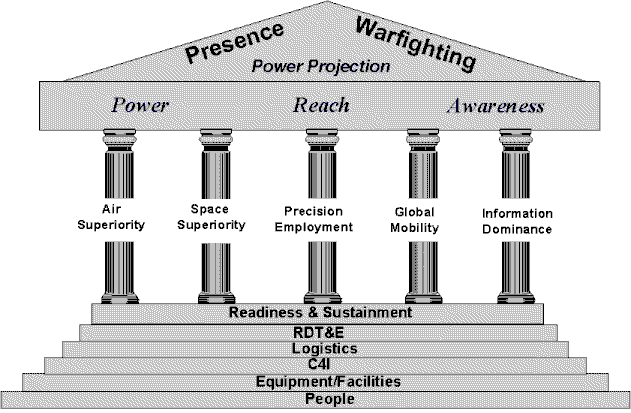
MISSION
Science and Technology (S&T) efforts are integral to the Air Force Vision. As Commander of the Air Force Materiel Command, General Ronald W. Yates established a goal to Sustain Technological Superiority: Our S&T mission is to nurture the right technologies and apply them rapidly to operational needs.
The S&T mission is linked to the Air Force Vision via the five core competencies illustrated above. Note that S&T activities are not confined to any particular level of the "foundation" of the core competencies. Rather, they permeate the entire framework and are therefore responsive to the assumptions and guidance for all five of the core competencies.
FUTURE
Most of the Air Force’s aviation S&T efforts are managed by the Wright Laboratory, one of the four "Super Labs" in the Air Force Materiel Command (AFMC). Other efforts are managed by Armstrong Lab (Human Systems Center), Phillips Lab (Space and Missile Systems Center), Rome Lab (Electronic Systems Center), and the Air Force Office of Scientific Research. Each of these five S&T organizations is responsive to the operational community through the AFMC Technology Master Process. The TMP is, in turn, an integral component of the overall Air Force Modernization Planning Process (AFMPP).
· Under the AFMPP, the five Major Commands (MAJCOMs) establish their weapon system requirements in Mission Area Plans (MAPs). Each MAP covers a twenty-five year planning period. The MAJCOM requirements, defined in the context of Operational Tasks, are known as User Deficiencies.
· The four AFMC Product Centers develop the materiel solutions to the User Deficiencies. The planning communities generate System Concepts as potential solutions to the User Deficiencies. These concepts form the basis for Technology Needs, which are used by the four labs and AFOSR to guide their S&T efforts.
· Throughout the planning process, the user-to-technologist linkage is facilitated by Technology Planning Integrated Product Teams (TPIPTs). Such a linkage ensures that User Deficiencies are well defined, and that the resulting S&T efforts are responsive to the user needs. The TPIPTs are administered by the four AFMC Product Centers.
Sixteen of the 35 Air Force Mission Areas rely upon aeronautical systems for successful completion of the Operational Tasks. Not surprisingly, the Air Force uses a diverse force of aviation systems to accomplish the many dissimilar missions. Four of the five MAJCOMs "own" aviation systems and plan for them in their Mission Area Plans. The MAPs describe, in substantial detail, the plans for each type of system. Due to the huge number of system types, the only practical way to summarize the Mission Area Plans in this document is through Force Structure "Sand Charts".
Air Combat Command
Air Combat Command (ACC) employs aviation systems in ten of their mission areas. These mission areas account for the vast majority of aviation systems employed by the Air Force (about 3400 systems in FY97). Due to the large number of systems, the force structure is depicted in three separate figures. The first figure depicts "traditional" combat aircraft systems employed in the fighter, bomber, and attack roles. The second figure depicts the force structure for ACC’s airlift and rescue assets. All other ACC aircraft systems are identified in the third figure.
For the next 25 years, ACC will have to rely upon existing systems, with only a few new types entering service. The greatest challenges for S&T may be in affordably maintaining the viability of aging systems.
ACC mission areas employing aircraft:
· Force Application · Combat Delivery
· Aerospace Control · Electronic Warfare
· Rescue · Strategic Air Defense
· Theater Battle Management · Surveillance & Reconnaissance
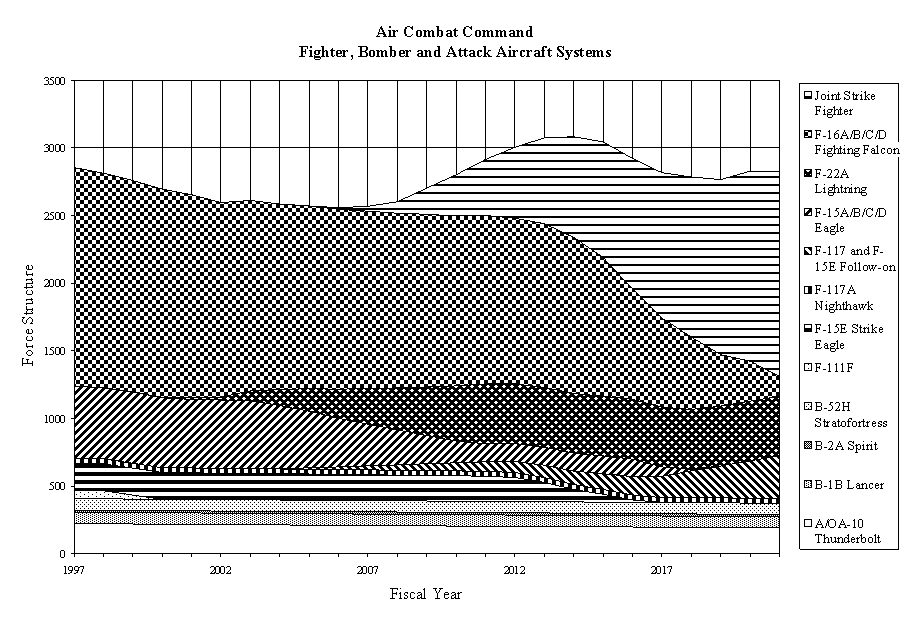

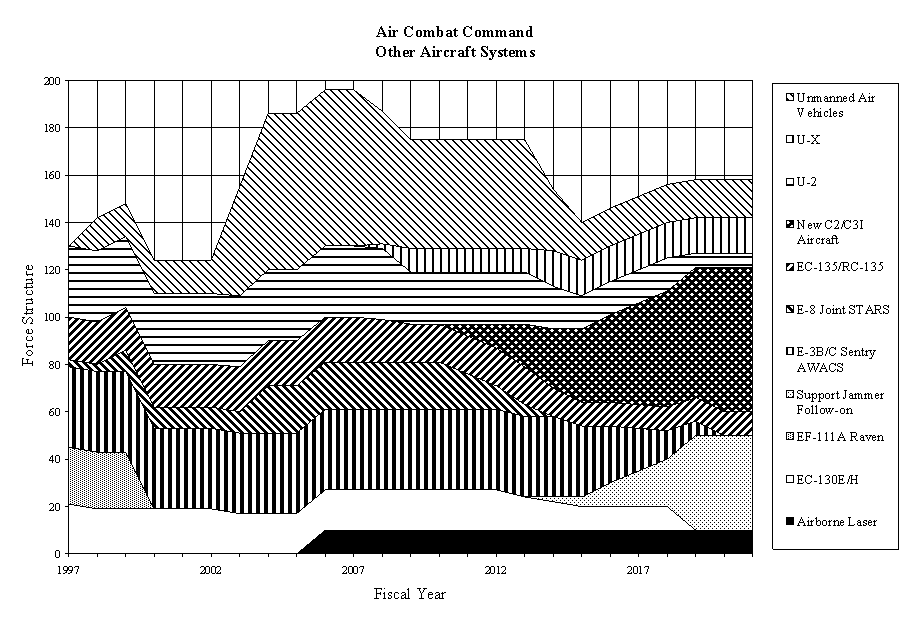
Air Education and Training Command: Air Education and Training Command (AETC) executes the Flying Training mission area (among others). This mission area includes both pilot and navigator training. Note that the force structure does not depict the many aircraft types used for mission qualification (e.g., TF-15, TC-135, and TCH-53A). Very soon, the AETC fleet will be "all new" with the exception of the T/AT-38 and T-43 aircraft types.
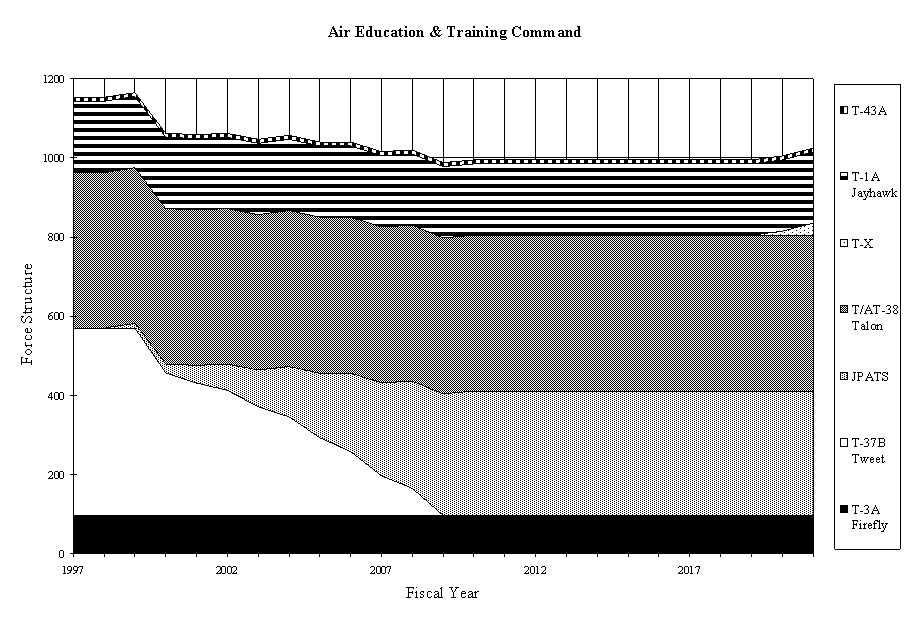
Air Force Special Operations Command:
Air Force Special Operations Command (AFSOC) has three mission areas that employ aircraft. Approximately 150 aircraft (in FY97) are dedicated to AFSOC missions. AFSOC is modernizing their fleet, so these mission areas offer many opportunities for aviation S&T in the near future. The mission areas are Force Application, Provide Mobility, and Psychological Operations.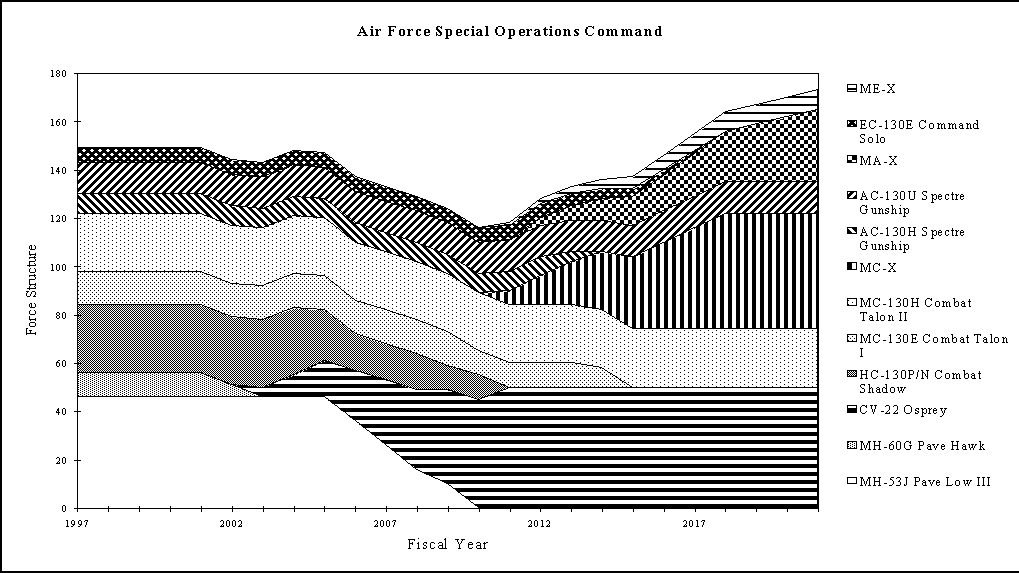
Air Mobility Command: The Air Mobility Command (AMC) has two mission areas: Air Refueling and Mobility. Note that the Mobility mission area includes several aircraft types that are dedicated to special missions (e.g. C-9, VC-25) and to the support of other MAJCOMs (e.g. C-23, UH-1). The force structure depicted below covers the core airlift and tanker functions.
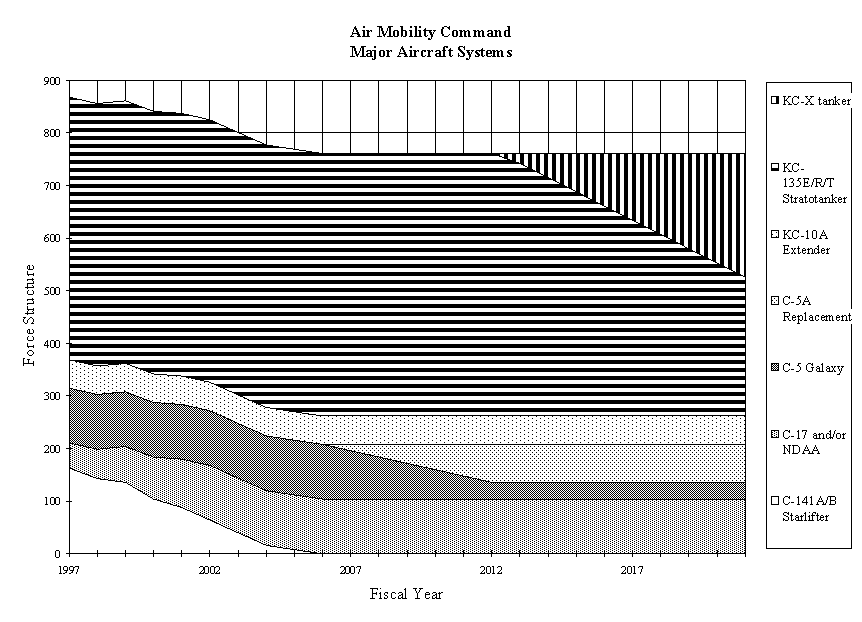
Air Force Space Command
Of the five MAJCOMs, only Air Force Space Command (AFSPC) does not have any dedicated aviation systems. In fact, aviation systems used by AFSPC are managed by Air Mobility Command. For example, the UH-1 helicopters used for missile site support actually "belong" to the AMC Airlift mission area.
S&T REQUIREMENTS
In 1994, the Mission Area Plans contained a total of 882 User Deficiencies. Many are related to aviation, and many require S&T efforts for complete resolution. The Air Force planning community and S&T community are working to develop technology planning guidance from the User Deficiencies. At the same time, they are working with the MAJCOMs to improve the definition of the deficiencies.
In late 1995, the Technology Master Process (a sub-process of the AFMPP) had expected to release two key documents¾ the Technology Investment Recommendation Report (TIRR) and the Product Technology Plan (PTP). To date, the TIRR has not been released. Together, the TIRR and PTP will complete the linkage of User/Operator-to-Technologist. Currently, the DOD Technology Development Approach is being linked to the AFMPP through the TPIPTs.,
JOINT EFFORTS
Each mission area looks beyond Air Force S&T for solutions. Certainly, many solutions do not require S&T efforts¾ they are ready for acquisition, or off-the-shelf technology is ready for insertion. However, the MAJCOMs recognize that the other services also have solutions that may meet their needs. For example:
· The ACC Rescue mission area employs HH-60G helicopters. Technology options that may meet Air Force needs for life extension and enhancement have already been examined by the Army.
· The Joint Primary Aircraft Training System (JPATS) will meet several AETC flying training requirements, allowing the retirement of aging T-37 aircraft.
· The Air Force and Navy jointly develop aircraft structures technology, for both future and existing systems. The Joint Advanced Strike Technology (JAST) program provides one forum for similar cooperative technology development efforts.
To be sure, the Air Force has more needs than dollars. Successful accomplishment of the Air Force mission will require a large portfolio of joint technology development efforts.